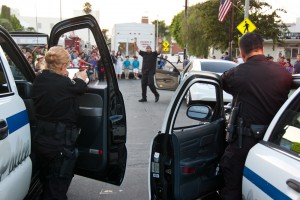
Hello everyone,
It’s been quite a while since I’ve written, and I’m sorry for that. Like I said in one of my last posts, I’m back in school now and my writing time is pretty focused on homework these days.
Those of you who have been watching our page over the last few weeks may have noticed a number of stories about our officers taking guns, both real and replica, off the streets after car stops, search warrants, or other arrests. One of the stories I wrote a couple of weeks ago mentioned what we call a high-risk car stop, with a very brief explanation of what it is and why we do it. I got some good feedback on that, so I thought I would offer a little more background about the tactic and how something that looks so dangerous or aggressive can actually help keep us all safer and prevent the need for force.
Stopping cars can be a risky business, and even a stop without any known red flags can be full of hidden dangers. We do tens of thousands of vehicle stops each year in Santa Rosa, and they go well most of the time. Sometimes we stop cars for minor traffic violations, sometimes to investigate other crimes, and sometimes we have to stop vehicles when we know or suspect that we will be detaining people who are armed and/or dangerous. That last group frequently includes people wanted for felonies who are likely to fight or flee.

We don’t want to overreact on the job, but in that last category of stops, when we have reason to believe that there is real danger, we also don’t want to encourage a violent reaction by being under-prepared. That is the realm of the high-risk car stop. We want to make sure we have enough officers there to safely handle the situation. Once we have enough police cars and officers ready, we’ll try to pick a safe spot to stop the car. We frequently need quite a few officers to handle the stop itself, block traffic and monitor the surroundings.
Before choosing a location for the stop we consider the street conditions, crowds and surroundings, traffic conditions, escape routes, available cover, etc. As an example, we would not want to do a high-risk car stop in front of the suspect’s house or near a school. Both spots would be too dangerous for different reasons. If the suspects don’t stop right away though, we have to adapt our tactics to the situation.
Once we get the car stopped, we use our cars to block traffic and serve as cover in case the suspects start shooting at us. We stay behind the cover of our cars with our guns aimed at the suspects while we give them very loud commands. This can look aggressive or even unnecessary to bystanders who probably don’t know why we are acting that way, but it is a tactic meant to keep everyone safer.
Walking up to a car we think is occupied by armed or dangerous people puts everyone at greater risk because we are putting ourselves in jeopardy and perhaps helping to create a situation where we may have to defend ourselves from a violent attack. If we can stay in a safer position while holding the potentially armed or violent suspects at gunpoint, we are better prepared to respond to an attack and we can slow the encounter down. Using time and distance to our advantage helps us avoid a violent confrontation. Things are always riskier at close range! Once we call the suspects out of the car and get them handcuffed and detained, we can continue our investigation much more safely. The technique helps us avoid what we call creating our own exigency.
As I mentioned in an earlier post, if you see this type of activity, please don’t stand around to watch or record the event. If we have our guns out, it is for a reason and we don’t want you to stay in harm’s way to watch. It is dangerous for you and limits our options to safely resolve the situation. If we yell at you to get out of the way, please understand we’re not trying to be rude, but we have other things we are trying to do and we don’t have time right then to explain. If we see you when it is over, we’d be happy to talk with you.
As always, thanks for reading. Be safe, be kind, and look after each other.
– Captain Craig Schwartz
p.s. – The photo accompanying this article is at a demonstration by another agency, so please disregard all the people standing downrange of the officers, in what would be the line of fire.
This post was originally published on September 19, 2016 on Captain Schwartz’s blog.